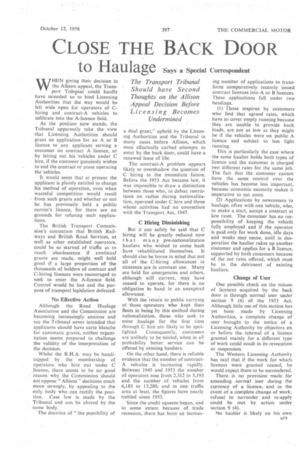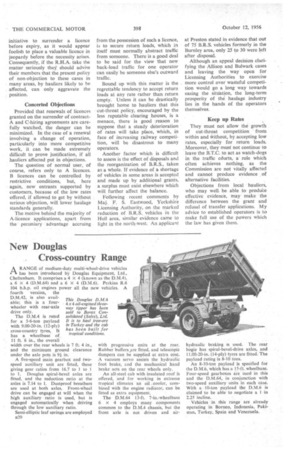CLOSE THE BACK DOOR
Page 53

Page 54

If you've noticed an error in this article please click here to report it so we can fix it.
to Haulage Says a Special Correspondent
The Transport Tribunal
• Should have Second Thoughts on the Allison Appeal Decision Before Licensing Becomes
Undermined
WHEN giving their decision in the Allison appeal, the Transport Tribunal could hardly have intended so to bind Licensing Authorities that the way would be left wide open for operators of Chiring and contract-A vehicles to infiltrate into the A-licence field.
As the position now stands, the Tribunal apparently take the view that Licensing Authorities should grant an application for an A or B licence to any applicant serving a customer on contract A licence, or by letting out his vehicles under C hire, if the customer genuinely wishes to end the contract or cease operating the vehicles.
It would seem that at present the applicant is plainly entitled to change his method of operation, even when wasteful competition would result from such grants and whether or not he has previously held a public carrier's licence, for there are no grounds for refusing such applications.
The British Transport Commission's contention that British Railways and British Road Services, as well as other established operators, could be so starved of traffic as to reach obsolescence if continual grants are made, might well hold good if a large proportion of the thousands of holders of contract and C-hiring licences were encouraged to seek to enter the A-licence field. Control would be lost and the purpose of transport legislation defeated.
No Effective Action
Although the Road Haulage Association and the Commission are becoming increasingly anxious and say the Tribunal never intended that applicants should have carte blanche for automatic grants, neither organization seems prepared to challenge the validity of the interpretation of the decision.
Whilst the R.H.A. may be handicapped by the membership of operators who hire out under C licence, there seems to be no good reason why the Commission should not oppose " Allison " decisions much more strongly, by appealing to the only body who can rectify the position. Case law is made by the Tribunal and can be altered by the same body.
The doctrine of "the possibility of a dual grant," upheld by the Licensing Authorities and the Tribunal in many cases before Allison, which once effectually curbed attempts to enter by the back door, could have a renewed lease of life.
The contract-A problem appears likely to overshadow the question of C hiring in the immediate future. Before the 1953 Act became law, it was impossible to draw a distinction between those who, to defeat restrictions on radius during nationalization, operated under C hire and those whose activities had no connection with the Transport Act, 1947.
C Hiring Diminishing But it can safely be said that C hiring will be greatly reduced now that many pre-nationalization hauliers who wished to come back have rehabilitated themselves. It should also be borne in mind that not all of the C-hiring allowances in existence are in constant use. Many are held for emergencies and others, although still current, may have ceased to operate, for there is no obligation to hand in an unexpired allowance.
With the return to public carrying ot those operators who kept their fleets in being by this method during nationalization, those who seek to enter haulage for the first time through C hire are likely to be spotlighted. Consequently, customers are unlikely to be misled, when in all probability better service can be offered by existing hauliers.
On the other hand, there is reliable evidence that the number of con tractA vehicles is increasing rapidly. Between 1945 and 1953 the number of operators rose from 2,312 to 5,193 and the number of vehicles from 6,183 to 13,280, and in one traffic area at least, the figures have nearly trebled since 1953.
, Since the credit squeeze began, and to some extent because of trade recession, there has been an increas ing number of applications to transform comparatively recently issued contract licences into A or B licences. These applications fall under two headings.
(1) Those inspired by customers who find that agreed rates, which have to cover empty running because they are unable to provide back loads, are not as low as they might be if the vehicles were on public A licence and subject to less light running.
This is particularly the case where the same haulier holds both types of licence and the customer is charged two different rates for the same job. The fact that the customer cannot have the same control over the vehicles has become less important, because economic necessity makes it imperative to cut costs.
(2) Applications by newcomers to haulage, often with one vehicle, who, to make a start, accept a contract at low rates. The customer has no responsibility of keeping the vehicle fully employed and if the operator is paid only for work done, idle days and weeks may ensue, until in desperation the haulier rakes up another customer and applies for a B licence, supported by both customers because of the cut rates offered, which must be to the detriment of existing hauliers.
Change of User One possible check on the misuse of licences acquired by the back door is through normal user under section 9 (4) of the 1953 Act. Although little use of this section has yet been made by Licensing Authorities, a complete change of user brought to the notice of a Licensing Authority by objectors on or before the renewal of a licence granted mainly for a different type of work could result in its revocation or suspension.
The Western Licensing Authority has said that if the work for which licences were granted ceased, he would expect them to be surrendered.
There is no provision made for amending normal user during the currency of a licence, and in the event of a complete change of work, refusal to surrender and re-apply could be met by action under section 9 (4)..
No haulier is likely on his own RI 9 initiative to surrender a licence before expiry, as it would appear foolish to place a valuable licence in jeopardy before the necessity arises. Consequently, if the R.H.A. take the matter seriously the 'y should advise their members that the present policy of non-objection to these cases in many areas, by hauliers likely to be affected, can only aggravate the position.
Concerted Objections
Provided that renewals of licences granted on the surrender of contractA and C-hiring agreements are carefully watched, the danger can be minimized. In the case of a renewal involving a change of operation, particularly into more competitive work, it can be made extremely difficult to prove justification, if all hauliers affected put in objections.
The question of normal user, of course, refers only to A licences. 13 licences can be controlled by restrictive conditions, but, here again, new entrants supported by customers, because of the low rates offered, if allowed to get by without serious objection, will lower haulage standards generally.
The motive behind the majority of A-licence applications, apart from the pecuniary advantage accruing from the possession of such a licence, is to secure return loads, which in itself must normally abstract traffic from someone. There is a good deal to be said for the view that new back-load traffic for one operator can easily be someone else's outward traffic.
Bound up with this matter is the regrettable tendency to accept return loads at any rate rather than return empty. Unless it can be drastically brought home to hauliers that this cut-throat policy, encouraged by the less reputable clearing houses, is a menace, there is good ,reason to suppose that a steady deterioration of rates will take place, which, in face of increasing railway competition, will be disastrous to many operators.
Another factor which is difficult to assess is the effect of disposals and the reorganization of B.R.S., taken as a whole. If evidence of a shortage of vehicles in some areas is accepted and made up by additional grants, a surplus must exist elsewhere which will further affect the balance.
Following recent comments by Maj. F. S. Eastwood, Yorkshire Licensing Authority, on the marked reduction of B.R.S. vehicles in the Hull area, similar evidence came to light in the north-west. An applicant
at Preston stated in evidence that out of 75 B.R.S. vehicles formerly in the Burnley area, only 25 to 30 were left after disposal.
Although an appeal decision clarifying the Allison and Bulwark cases and leaving the way open for Licensing Authorities to exercise more control over wasteful competition would go a long way towards easing the situation, the long-term prosperity of the haulage industry lies in the hands of the operators themselves.
Keep up Rates They must not allow the growth of cut-throat competition from within and Without, by accepting low rates, especially for return loads. Moreover, they must not continue to leave the B.T.C. to act as watch-dogs in the traffic cdurts, a role which often achieves nothing, as the Commission are not vitally affected and cannot produce evidence of alternative facilities.
Objections from local hauliers, who may well., be able to produZe effective evidence, may make the difference between the grant and refusal of transfer applications. My advice to established operators is to make full use of the powers which the law has given them.




















































































































